A Dynamic Constitutive Model and Simulation of Braided CFRP under High-Speed Tensile Loading
Abstract
:1. Introduction
2. Dynamic Constitutive Model
2.1. Traditional Composite Constitutive Model
2.2. Modified Dynamic Constitutive Model
3. Finite Element Model
3.1. UMAT
3.2. Dynamic Tensile FE Model
4. Analysis of Simulation Results
4.1. Comparison of Experimental and Simulation Results
4.2. Stress and Failure Contour Maps
4.3. Analysis of the Strain Rate Effect on the Modulus and Strength
4.4. Additional Parametric Analysis
5. Conclusions
- The results simulated with the dynamic constitutive model were in good agreement with the stress–strain curves and strain distributions from the tests during different stages. In the linear elastic stage of the test, the strain distributions of the specimens were relatively uniform. When the strain value reached 0.012–0.013, the strain field turned non-uniform, and failure occurred in the form of a brittle fracture. For the [0/90/±45]3s lay-up, as the strain rate increased, the input modulus decreased, the tensile strength decreased, and the stress decreased under a constant displacement. Comparing the three lay-ups considered, the [0/90]12 lay-up resulted in the highest stress for a given displacement, with failure mainly consisting of fiber tensile fracture.
- For the same specimen, the strain rate was the lowest at both clamped ends and the largest at the middle section. On the contrary, the modulus was high on both ends and small in the middle. On the other hand, the strength was the smallest at the clamped ends, decreasing at the transition region and increasing again toward the middle section where the strain rate was high. Combined with the simulation of additional lay-ups, strain rates, and thicknesses, it was found that the fitting curve in the test is completely input into the dynamic constitutive model, which can better reflect the dynamic variation rules of the different material properties. It was also found that the tensile strength of the material and the slope of the curve increased as the percentage of 0/90 angle lay-ups increased, while as the percentage of ±45 angle lay-ups increased, the curve tended to fluctuate. As the strain rate increased, the slope of the curve decreased, and the strength of the material increased.
- The dynamic properties of woven CFRP have not yet been extensively studied. Different resins, fibers, and weaving methods can affect the dynamic properties of the material. In the field of rail transportation, the application of composite materials is gradually increasing. Research on dynamic constitutive models of composite materials enables a better simulation of the bearing capacity and energy absorption characteristics of the structure during train collisions, which may significantly promote the application of carbon fiber composites in other multiple fields.
Author Contributions
Funding
Conflicts of Interest
References
- Reis, V.; Opelt, C.; Cândido, G.; Rezende, M.; Donadon, M. Effect of fiber orientation on the compressive response of plain weave carbon fiber/epoxy composites submitted to high strain rates. Compos. Struct. 2018, 203, 952–959. [Google Scholar] [CrossRef]
- Rad, C.V.; Kodagali, K.; Roark, J.; Revilock, D.; Ruggeri, C.; Harik, R.; Sockalingam, S. High velocity impact response of hybridized pseudo-woven carbon fiber composite architectures. Compos. Part B Eng. 2020, 203, 108478. [Google Scholar] [CrossRef]
- Azadi, M.; Sayar, H.; Ghasemi-Ghalebahman, A.; Jafari, S.M. Tensile loading rate effect on mechanical properties and failure mechanisms in open-hole carbon fiber reinforced polymer composites by acoustic emission approach. Compos. Part B Eng. 2019, 158, 448–458. [Google Scholar] [CrossRef]
- Guedes, R.; de Moura, M.; Ferreira, F. Failure analysis of quasi-isotropic CFRP laminates under high strain rate compression loading. Compos. Struct. 2008, 84, 362–368. [Google Scholar] [CrossRef]
- Al-Zubaidy, H.; Zhao, X.-L.; Al-Mahaidi, R. Mechanical characterisation of the dynamic tensile properties of CFRP sheet and adhesive at medium strain rates. Compos. Struct. 2012, 96, 153–164. [Google Scholar] [CrossRef]
- Naik, N.; Yernamma, P.; Thoram, N.; Gadipatri, R.; Kavala, V. High strain rate tensile behavior of woven fabric E-glass/epoxy composite. Polym. Test. 2010, 29, 14–22. [Google Scholar] [CrossRef]
- Naresh, K.; Shankar, K.; Rao, B.; Velmurugan, R. Effect of high strain rate on glass/carbon/hybrid fiber reinforced epoxy laminated composites. Compos. Part B Eng. 2016, 100, 125–135. [Google Scholar] [CrossRef]
- Zhang, X.; Shi, Y.; Li, Z.-X. Experimental study on the tensile behavior of unidirectional and plain weave CFRP laminates under different strain rates. Compos. Part B Eng. 2019, 164, 524–536. [Google Scholar] [CrossRef]
- Weng, F.; Fang, Y.; Ren, M.; Sun, J.; Feng, L. Effect of high strain rate on shear properties of carbon fiber reinforced composites. Compos. Sci. Technol. 2020, 203, 108599. [Google Scholar] [CrossRef]
- Ahmed, A.; Rahman, Z.; Ou, Y.; Liu, S.; Mobasher, B.; Guo, S.; Zhu, D. A review on the tensile behavior of fiber-reinforced polymer composites under varying strain rates and temperatures. Constr. Build. Mater. 2021, 294, 123565. [Google Scholar] [CrossRef]
- Xia, Y.M.; Wang, X. Constitutive equation for unidirectional composites under tensile impact. Compos. Sci. Technol. 1996, 56, 155–160. [Google Scholar]
- Wang, Y.; Xia, Y. A modified constitutive equation for unidirectional composites under tensile impact and the dynamic tensile properties of KFRP. Compos. Sci. Technol. 2000, 60, 591–596. [Google Scholar] [CrossRef]
- Tan, W.; Liu, B. A physically-based constitutive model for the shear-dominated response and strain rate effect of carbon fibre reinforced composites. Compos. Part B Eng. 2020, 193, 108032. [Google Scholar] [CrossRef]
- Sato, M.; Shirai, S.; Koyanagi, J.; Ishida, Y.; Kogo, Y. Numerical simulation for strain rate and temperature dependence of transverse tensile failure of unidirectional carbon fiber-reinforced plastics. J. Compos. Mater. 2019, 53, 4305–4312. [Google Scholar] [CrossRef]
- Koyanagi, J.; Kawamoto, K.; Higuchi, R.; Tan, V.B.C.; Tay, T.-E. Direct FE2 for simulating strain-rate dependent compressive failure of cylindrical CFRP. Compos. Part C Open Access 2021, 5, 100165. [Google Scholar] [CrossRef]
- Sawamura, Y.; Yamazaki, Y.; Yoneyama, S.; Koyanagi, J. Multi-scale numerical simulation of impact failure for cylindrical CFRP. Adv. Compos. Mater. 2020, 30, 19–38. [Google Scholar] [CrossRef]
- Al-Zubaidy, H.; Al-Mahaidi, R.; Zhao, X.-L. Finite element modelling of CFRP/steel double strap joints subjected to dynamic tensile loadings. Compos. Struct. 2013, 99, 48–61. [Google Scholar] [CrossRef]
- Batuwitage, C.; Fawzia, S.; Thambiratnam, D.; Liu, X.; Al-Mahaidi, R.; Elchalakani, M. Impact behaviour of carbon fibre reinforced polymer (CFRP) strengthened square hollow steel tubes: A numerical simulation. Thin-Walled Struct. 2018, 131, 245–257. [Google Scholar] [CrossRef]
- Zhu, G.; Liao, J.; Sun, G.; Li, Q. Comparative study on metal/CFRP hybrid structures under static and dynamic loading. Int. J. Impact Eng. 2020, 141, 103509. [Google Scholar] [CrossRef]
- Kim, D.H.; Kang, S.Y.; Kim, H.J.; Kim, H.S. Strain rate dependent mechanical behavior of glass fiber reinforced polypropylene composites and its effect on the performance of automotive bumper beam structure. Compos. Part B Eng. 2019, 166, 483–496. [Google Scholar] [CrossRef]
- Rathod, R.S.B.; Goel, M.D.; Chakraborty, T.; Matsagar, V.; Guégan, P.; Binetruy, C. Experimental and numerical investigations on dynamic behavior of CFRP laminates. SN Appl. Sci. 2019, 1, 736. [Google Scholar] [CrossRef] [Green Version]
- Jiang, L.; Xiao, S.; Jiang, W.; Chen, D.; Yang, G.; Zhu, T.; Wang, M.; Yang, B. Effect of stacking configuration on dynamic tensile properties of braided carbon fibre composites under medium-low strain rates. Compos. Sci. Technol. 2021, 213, 108924. [Google Scholar] [CrossRef]
- Christensen, M.R. Mechanics of Composite Materials; Courier Corporation: Chicago, IL, USA, 2012. [Google Scholar]
- Tóth, L.S.; Molinari, A.; Bouaziz, O. Effective strain rate sensitivity of two phase materials. Mater. Sci. Eng. A 2009, 524, 186–192. [Google Scholar] [CrossRef]
- Yen, C.F. Ballistic impact modeling of composite materials. In Proceedings of the 7th international LS-DYNA Users Conference, Dearborn, MI, USA, 19–21 July 2002; Volume 6, pp. 15–23. [Google Scholar]
- Yen, C.F.; Caiazzo, A.A. Innovative Processing of Multifunctional Composite ARMOR for Ground Vehicles; Army Research Laboratory: Adelphi, MD, USA, 2001. [Google Scholar]
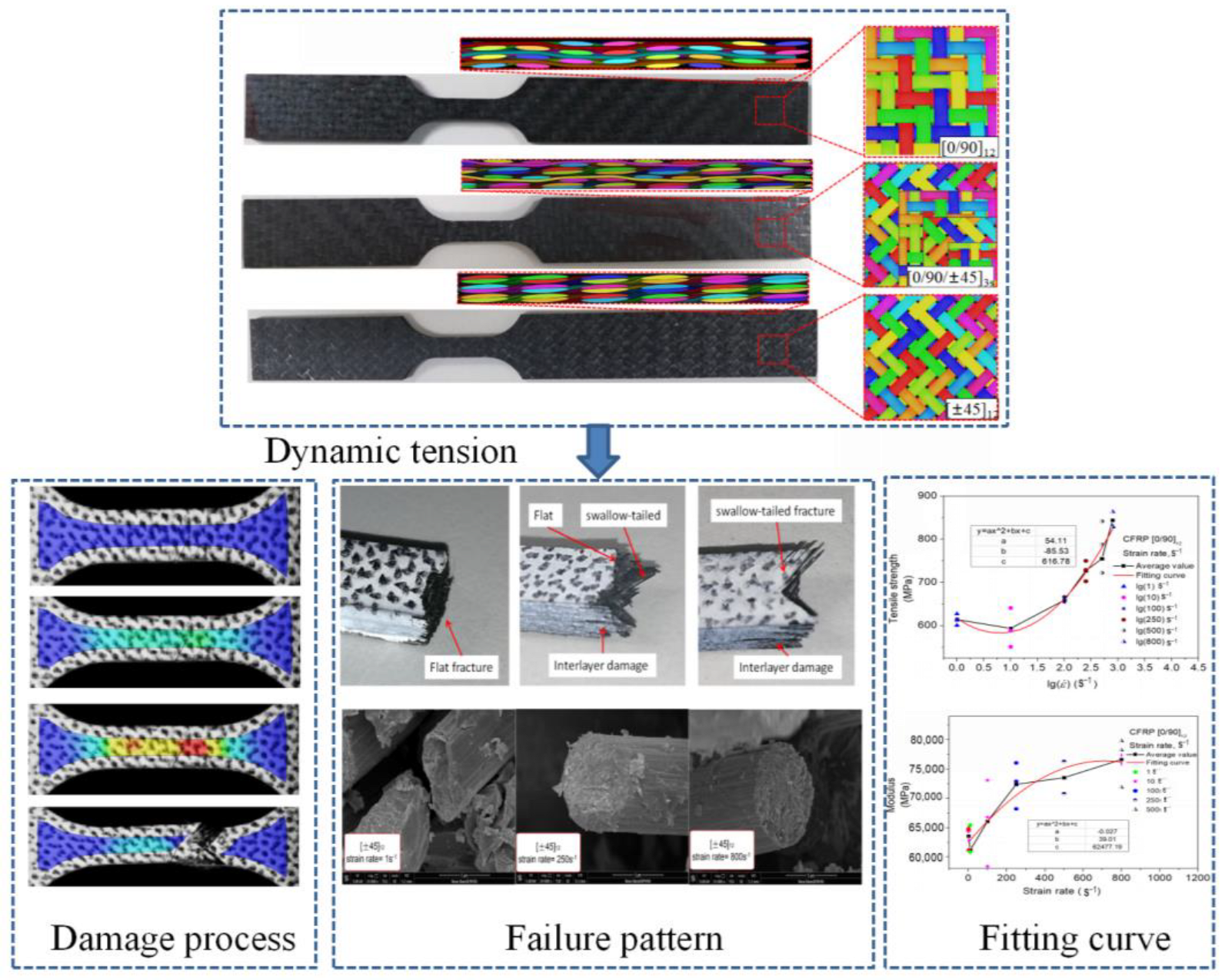
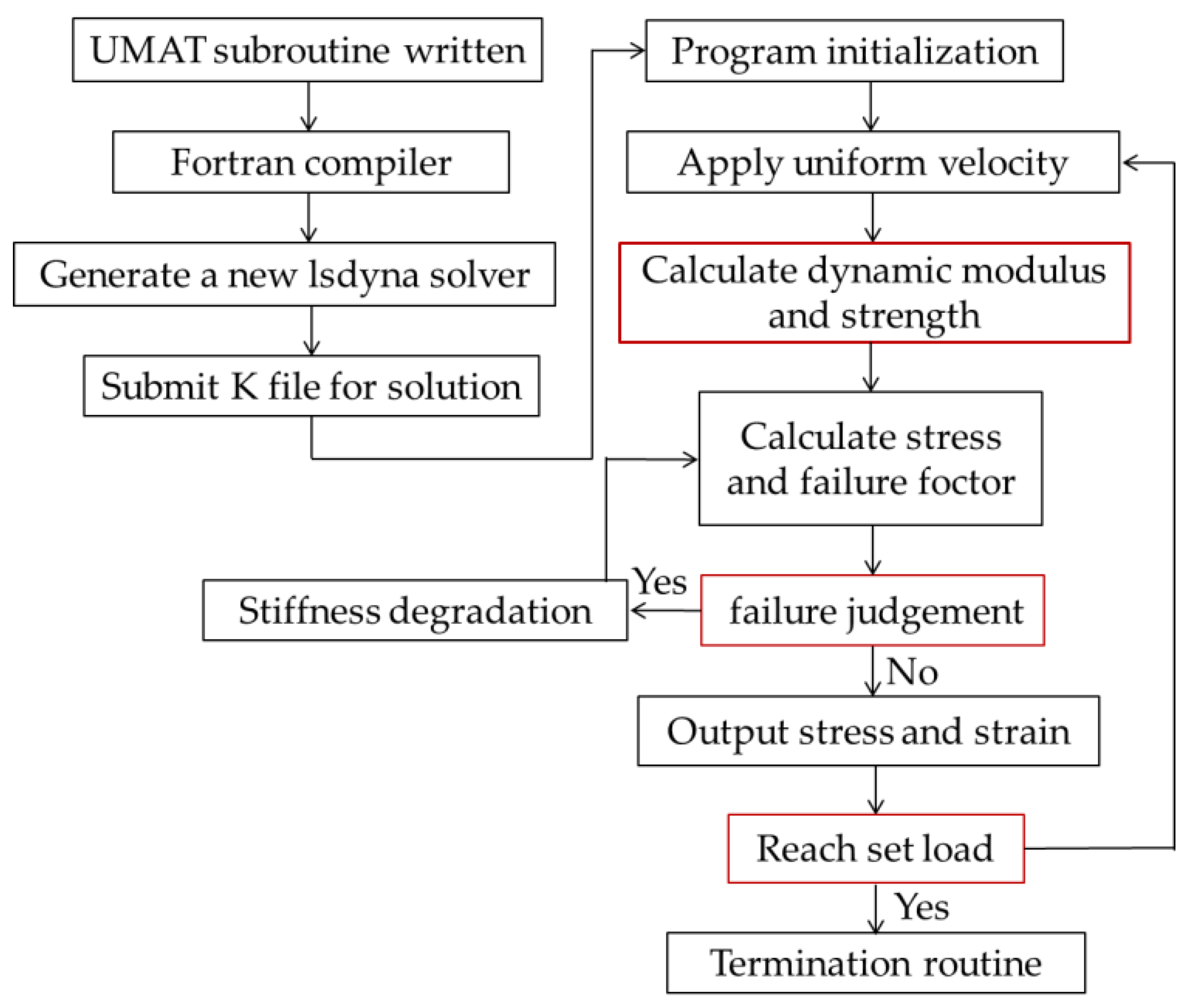
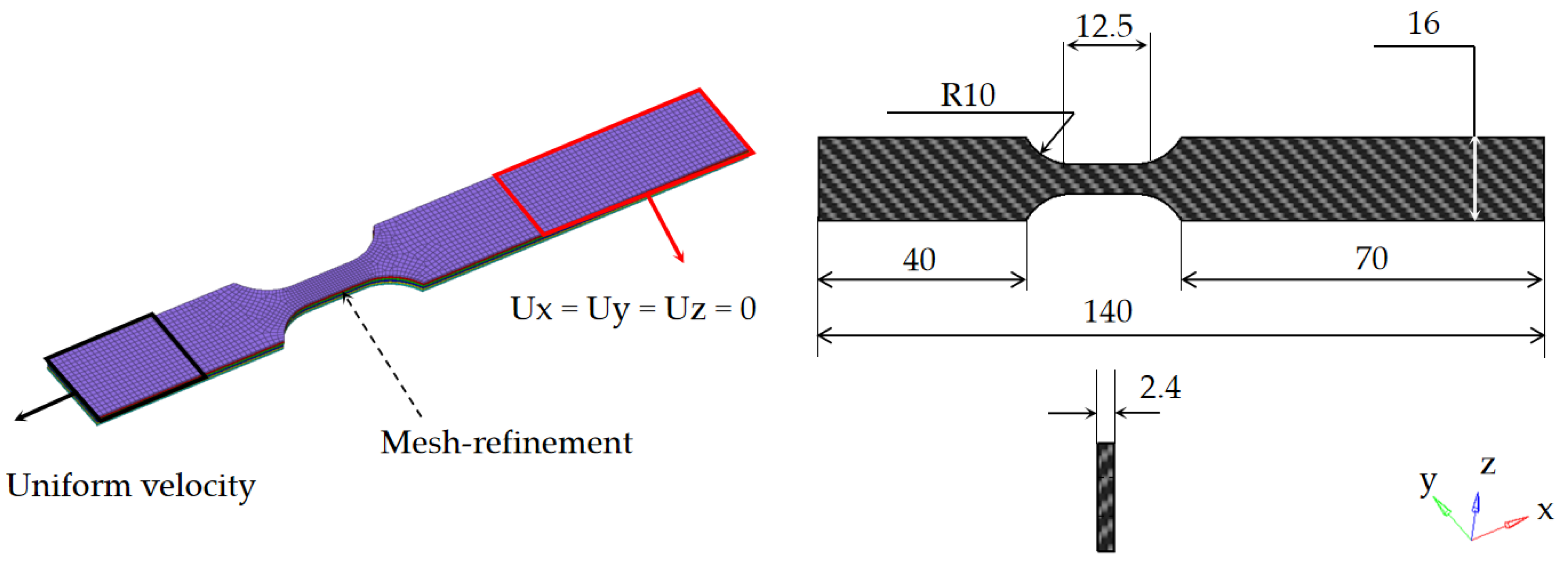
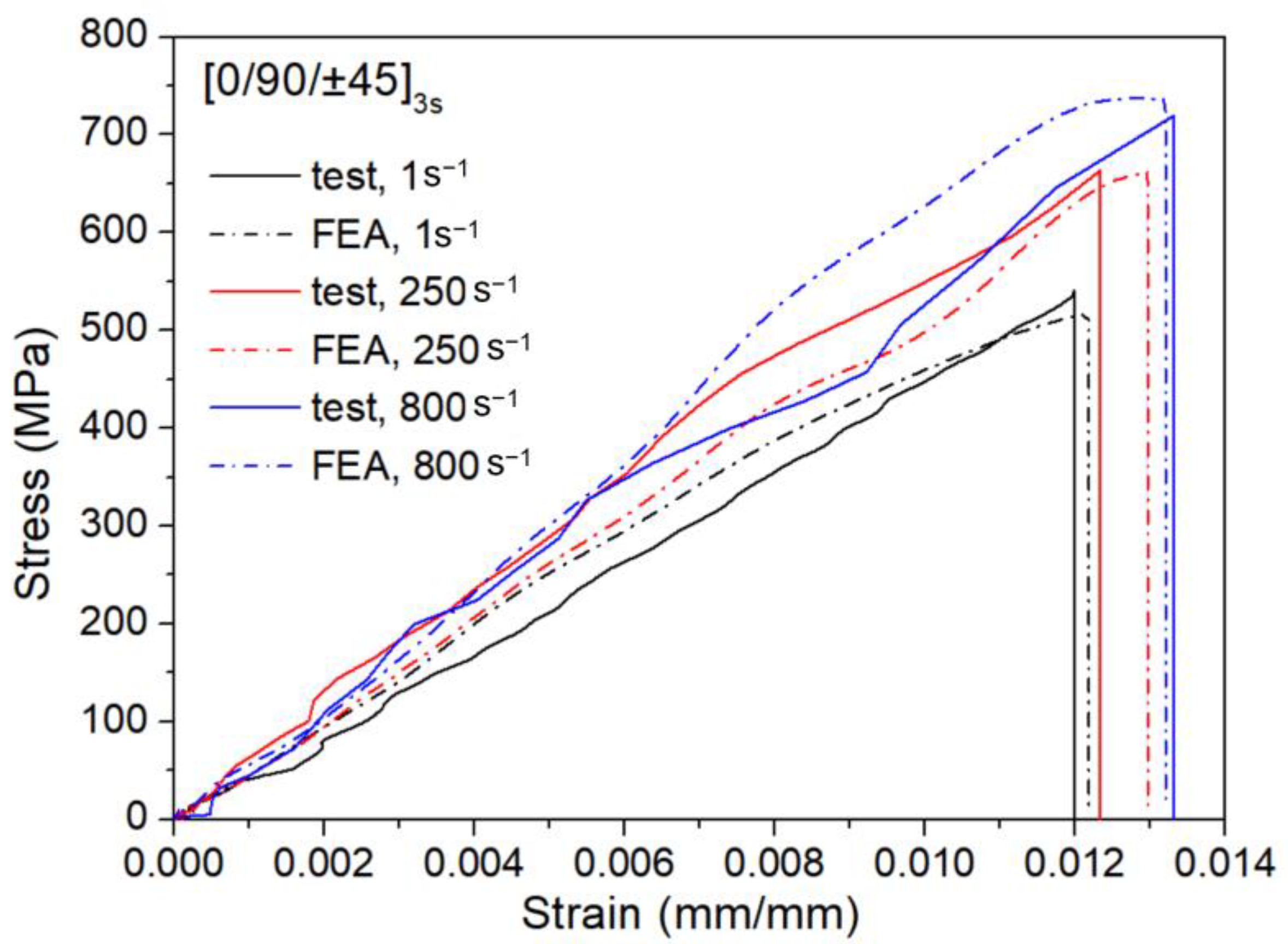
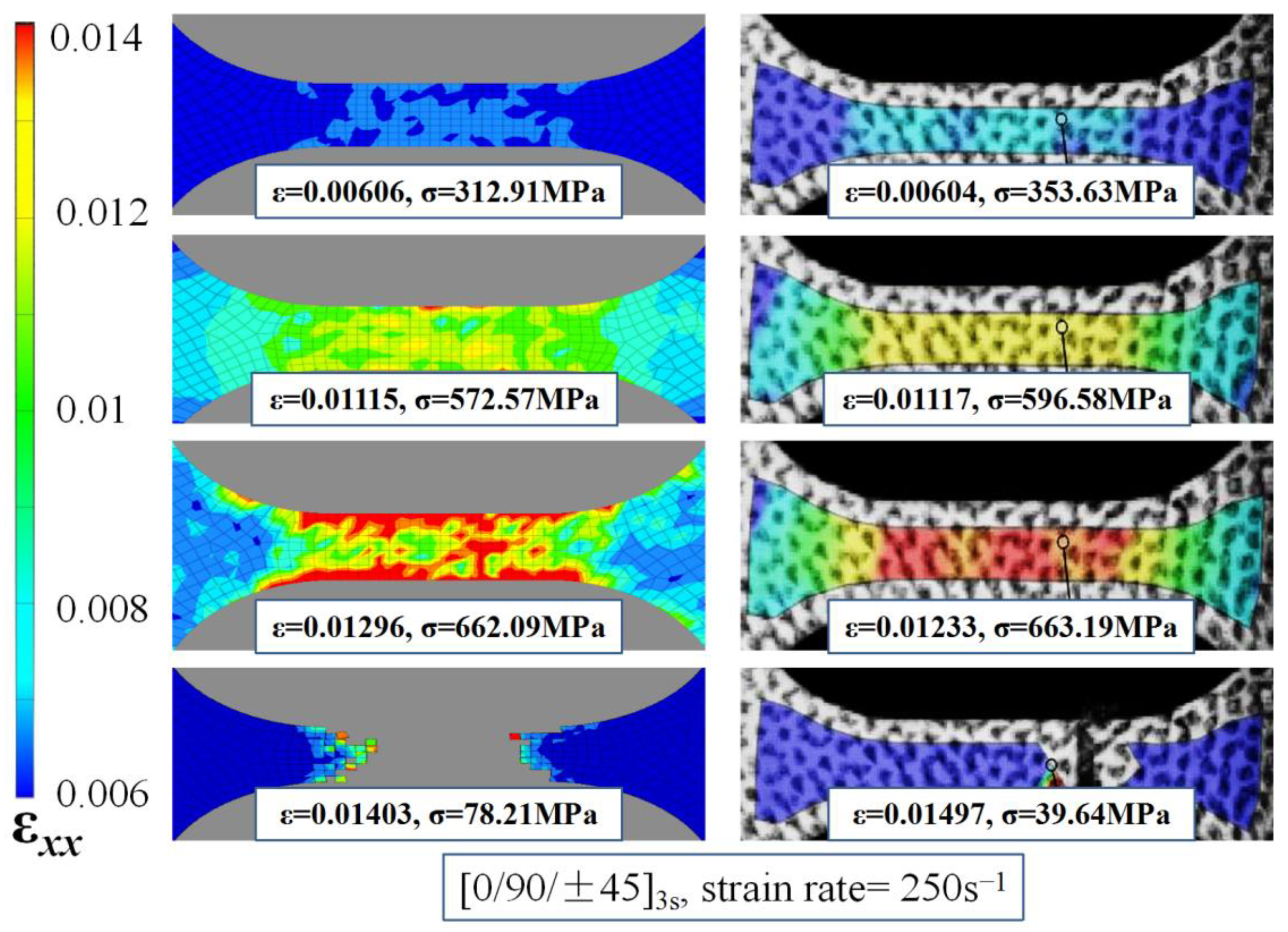
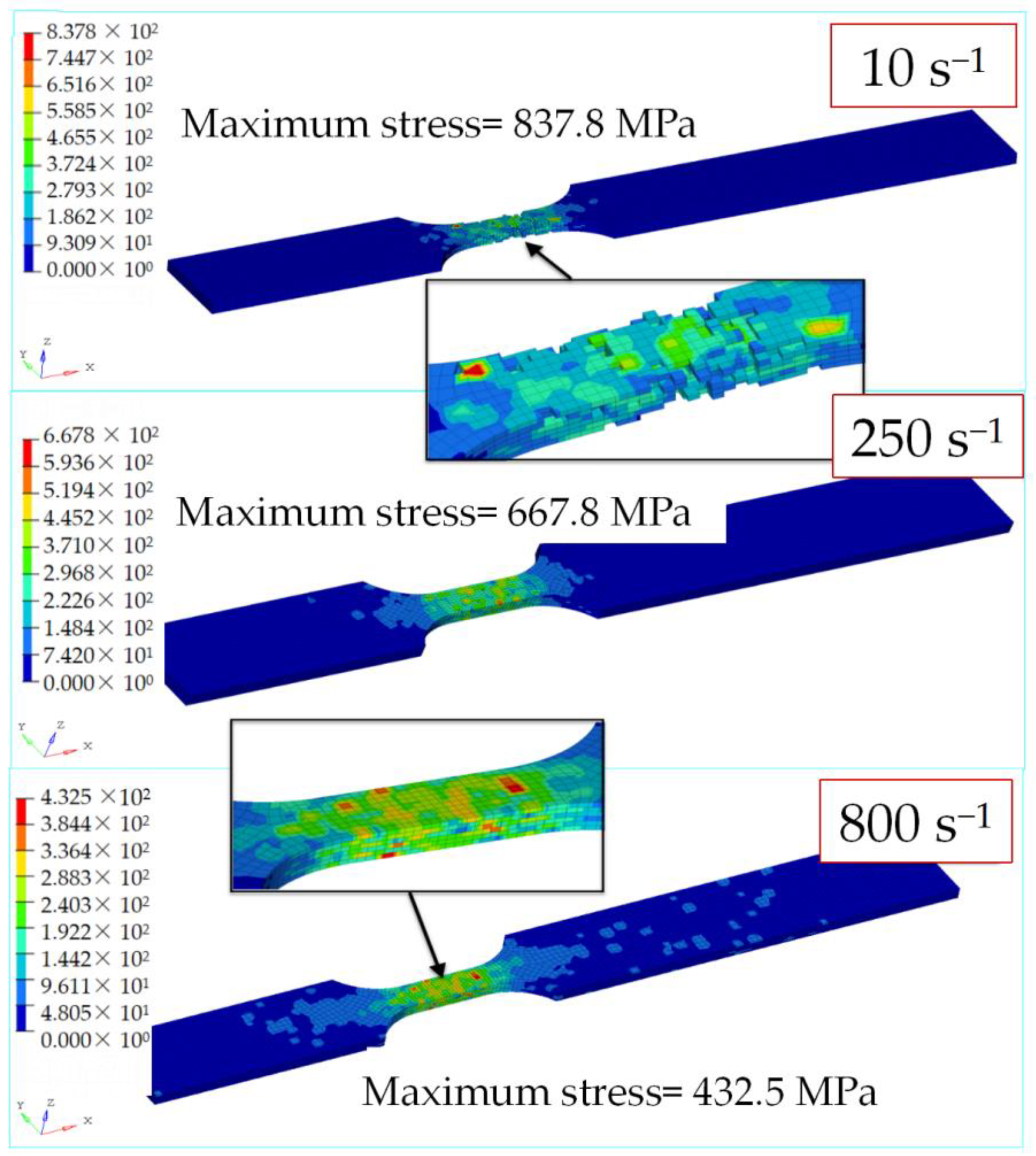



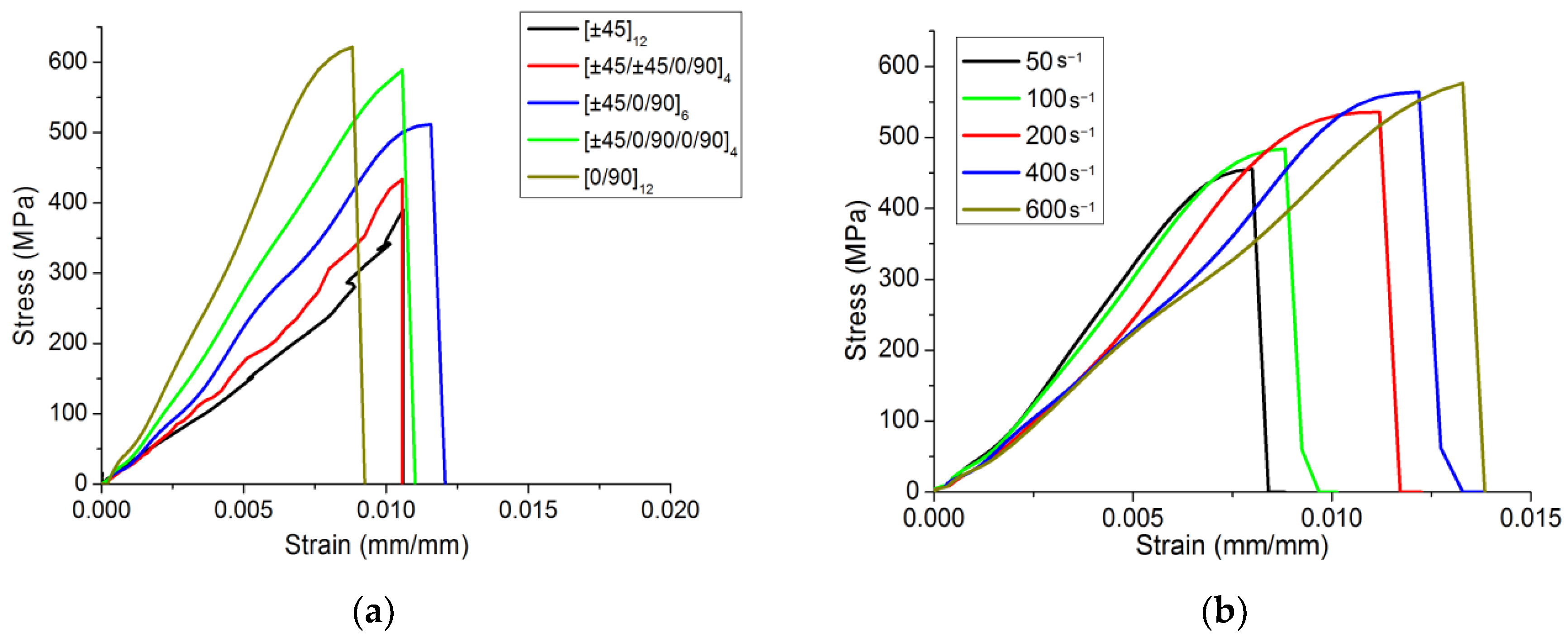
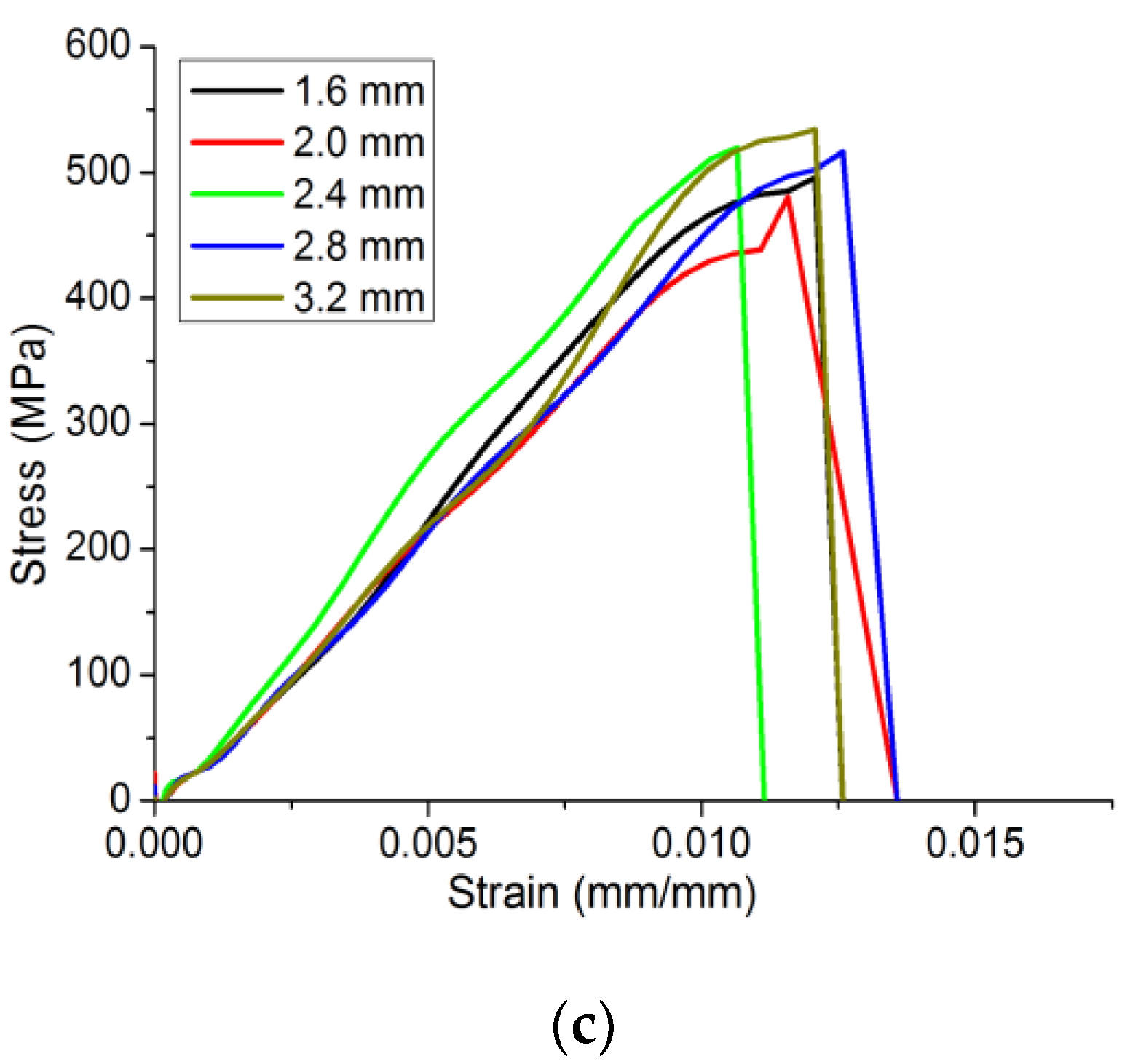
| Failure Mode | Failure Criteria | |
|---|---|---|
| Fiber tensile failure | (4) | |
| Fiber compressive failure | (5) | |
| Matrix tensile failure | (6) | |
| Matrix compressive failure | (7) | |
| Fiber-matrix shear-out failure | (8) | |
| Matrix tensile delamination failure | (9) | |
| Matrix compressive delamination failure | (10) | |
| Failure Mode | |||||||||
|---|---|---|---|---|---|---|---|---|---|
| Fiber tensile failure | 0.14 | 0.4 | 0.4 | 0.25 | 0.25 | 0.2 | 0 | 0 | 0 |
| Fiber compressive failure | 0.14 | 0.4 | 0.4 | 0.25 | 0.25 | 0.2 | 0 | 0 | 0 |
| Matrix tensile failure | - | 0.4 | 0.4 | - | - | 0.2 | 0 | 0 | 0 |
| Matrix compressive failure | - | 0.4 | 0.4 | - | - | 0.2 | 0 | 0 | 0 |
| Fiber-matrix shear-out failure | - | - | - | 0.25 | 0.25 | - | 0 | 0 | - |
| Matrix tensile delamination failure | - | - | 0 | - | 0 | 0 | - | 0 | - |
| Matrix compressive delamination failure | - | - | 0 | - | 0 | 0 | - | 0 | - |
| Parameter | Assigned Value | Parameter | Assigned Value |
|---|---|---|---|
| 64.00 GPa | 771.83 MPa | ||
| 64.00 GPa | 830.93 MPa | ||
| 10.30 GPa | 771.83 MPa | ||
| 4.97 GPa | 830.93 MPa | ||
| 4.97 GPa | 31.2 MPa | ||
| 3.50 GPa | 184 MPa | ||
| 0.066 | 107.7 MPa | ||
| 0.3 | 94.24 MPa | ||
| 0.3 | 94.24 MPa |
| Different Lay-Ups | [0/90]12 | [±45/0/90/0/90]4 | [±45/0/90]6 | [±45/±45/0/90]4 | [±45]12 |
|---|---|---|---|---|---|
| Different strain rates/s−1 | 50 | 100 | 200 | 400 | 600 |
| Different thicknesses/mm | 1.6 | 2 | 2.4 | 2.8 | 3.2 |
Publisher’s Note: MDPI stays neutral with regard to jurisdictional claims in published maps and institutional affiliations. |
© 2022 by the authors. Licensee MDPI, Basel, Switzerland. This article is an open access article distributed under the terms and conditions of the Creative Commons Attribution (CC BY) license (https://creativecommons.org/licenses/by/4.0/).
Share and Cite
Jin, W.; Zhang, Y.; Jiang, L.; Yang, G.; Chen, J.; Li, P. A Dynamic Constitutive Model and Simulation of Braided CFRP under High-Speed Tensile Loading. Materials 2022, 15, 6389. https://doi.org/10.3390/ma15186389
Jin W, Zhang Y, Jiang L, Yang G, Chen J, Li P. A Dynamic Constitutive Model and Simulation of Braided CFRP under High-Speed Tensile Loading. Materials. 2022; 15(18):6389. https://doi.org/10.3390/ma15186389
Chicago/Turabian StyleJin, Wei, Yingchuan Zhang, Lanxin Jiang, Guangwu Yang, Jingsong Chen, and Penghang Li. 2022. "A Dynamic Constitutive Model and Simulation of Braided CFRP under High-Speed Tensile Loading" Materials 15, no. 18: 6389. https://doi.org/10.3390/ma15186389
APA StyleJin, W., Zhang, Y., Jiang, L., Yang, G., Chen, J., & Li, P. (2022). A Dynamic Constitutive Model and Simulation of Braided CFRP under High-Speed Tensile Loading. Materials, 15(18), 6389. https://doi.org/10.3390/ma15186389







